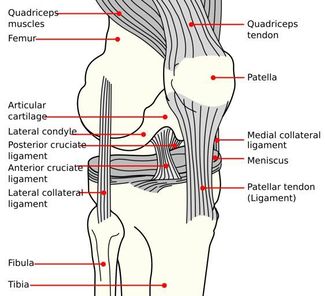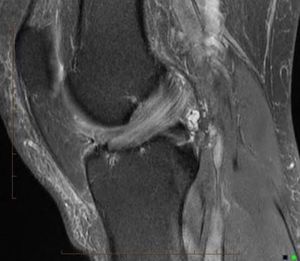Anterior Cruciate Ligament (ACL) Mucoid Degeneration: Difference between revisions
Keta Parikh (talk | contribs) No edit summary |
Kim Jackson (talk | contribs) m (Updated categories) |
||
| (35 intermediate revisions by 3 users not shown) | |||
| Line 1: | Line 1: | ||
<div class="editorbox"> | <div class="editorbox">'''Original Editor '''- [[User: Keta Parikh]] '''Top Contributors''' - {{Special:Contributors/{{FULLPAGENAME}}}}</div> | ||
'''Original Editor '''- [[User: | == Anatomy == | ||
[[File:Lig 5e4e49f37ddff80480a405a890a55e55ef8b9484.jpg|thumb|325x325px]][[Anterior Cruciate Ligament]], is an important structure of the knee joint. Anatomically, it is arranged in a crossed pattern with the [[Posterior Cruciate Ligament]], forming an 'X', therefore, it is also known as cruciform ligament. This ligament consists of two fibers, mainly, the anterio-medial and postero-lateral fibers, respectively. The ligament is mainly responsible for restraining anterior translation of knee. Along with that, it also controls the internal rotation. Therefore, Anterior Cruciate Ligament tear is more susceptible during any injury to the knee. The cruciate ligament have mechanoreceptors, which are responsible to detect any change in position of the knee, direction, speed and tension. It is lined by the synovial fluid, which provides the nutrition and plays an integral part in healing. | |||
'''Top Contributors''' - {{Special:Contributors/{{FULLPAGENAME}}}} | |||
</div> | |||
== | |||
Anterior Cruciate Ligament is an important structure of the knee joint. | |||
== What is Anterior Cruciate Ligament Mucoid Degeneration? == | == What is Anterior Cruciate Ligament Mucoid Degeneration? == | ||
This is a rare pathological condition, in which there is increased signal from within the ligament. Mucoid degeneration, is irreversible degeneration of the tissue with the infiltration of mucin within the fibers. Multiple theories have been put forth that explains the pathological | This is a rare pathological condition, in which, there is increased signal from within the ligament. Mucoid degeneration, is the irreversible degeneration of the tissue with the infiltration of mucin(glycosaminoglycans) within the fibers<ref>Palmer W, Bancroft L, Bonar F, Choi JA, Cotten A, Griffith JF, Robinson P, Pfirrmann CW. Glossary of terms for musculoskeletal radiology. Skeletal Radiology. 2020 Jun 2.</ref><ref name=":1" />. Multiple theories have been put forth that explains the pathological disorganization in the collagen fibers of the Anterior Cruciate Ligament, such as synovial, traumatic, and degenerative, "<u>Synovial” theory</u>- states that there is accumulation of synovial fluid inside the substance of ACL in a herniated pouch of synovium. "<u>Traumatic” theory</u> - post injury, ACL fibroblasts secrete glycosaminoglycans, the mucin substance within the ACL. Other theories include “<u>Degenerative” theory</u>- MD could occur due to ageing.<ref name=":0">Pandey, Vivek et al. “Mucoid degeneration of the anterior cruciate ligament: Management and outcome.” ''Indian journal of orthopaedics'' vol. 48,2 (2014): 197-202. doi:10.4103/0019-5413.128765</ref> | ||
== Clinical Findings == | == Clinical Findings == | ||
Painful knee flexion | * Painful terminal knee flexion<ref name=":1">el Kadi KI, Marcaillou F, Blanc S, Salloum B, Dimontagliari C, Boutayeb F. Mucoid degeneration of the anterior cruciate ligament: a case report. Pan African Medical Journal. 2013;15(1).</ref><ref name=":0" /> | ||
* Stiffness<ref name=":1" /> | |||
Stiffness | * No instability<ref name=":1" /><ref name=":0" /> | ||
* No extension block<ref name=":0" /> | |||
No extension block | * Joint line tenderness<ref name=":0" /> | ||
* Swelling<ref name=":0" /> | |||
Posterior knee pain | * Crepitation<ref name=":0" /> | ||
* Posterior knee pain<ref name=":0" /><ref name=":2">Lintz F, Pujol N, Dejour D, Boisrenoult P, Beaufils P. Anterior cruciate ligament mucoid degeneration: selecting the best treatment option. Orthopaedics & Traumatology: Surgery & Research. 2010 Jun 1;96(4):400-6.</ref> | |||
* Difficulty in climbing stairs, cross-leg sitting, squatting<ref name=":4">Loganathan D, Soma Sundar S, Sundar S, Sahanand S, Rajan DV. Mucoid degenerated anterior cruciate ligament (ACL) managed by arthroscopic ACL reconstruction: A case series. International Journal of Orthopaedics. 2018;4(4):875-80.</ref> | |||
== Causes == | == Causes == | ||
Trauma | * Acute/Repeated Trauma<ref name=":2" /><ref name=":3">Lintz F, Pujol N, Boisrenoult P, Bargoin K, Beaufils P, Dejour D. Anterior cruciate ligament mucoid degeneration: a review of the literature and management guidelines. Knee Surgery, Sports Traumatology, Arthroscopy. 2011 Aug 1;19(8):1326-33.</ref> | ||
* Ageing | |||
Ageing | * Primary condition- Osteoarthritis, degenerative menisci, meniscal tear<ref name=":0" />, Meniscectomy<ref name=":2" /> | ||
Primary condition- Osteoarthritis | |||
== Complications == | == Complications == | ||
Impingement | * Impingement of the soft tissue in the vicinity<ref name=":0" /> | ||
* Ganglionic cyst | |||
Ganglionic cyst | * Tendon tear/ Tendon rupture | ||
[[File:Mucoid.jpg|thumb]] | |||
Tendon tear/ Tendon rupture | |||
== Radiological Findings == | == Radiological Findings == | ||
=== | ==== MRI ==== | ||
* Characteristic: "celery stalk" appearance,<ref name=":2" /> reflects ACL degeneration. | |||
* Ligaments and tendons are accumulated by mucoid change might display a thickened and/or hypertrophied appearance, with an increase in signal intensity.<ref name=":0" /><ref name=":2" /> | |||
* Narrowing of the intercondylar notch<ref name=":4" /> | |||
* Sometimes, it is mislead as ACL tear on MRI findings, hence requires probing and histopathology for definitive diagnosis.<ref name=":0" /><ref name=":2" /> | |||
=== | ==== Arthroscopy ==== | ||
Arthroscopically ACL is intact but fibrillated, yellowish and hypertrophied, with interspersed yellowish mucinous material along the fibers, lack of synovial linning of the ACL | * Arthroscopically ACL is intact but fibrillated, yellowish and hypertrophied, with interspersed yellowish mucinous material along the fibers, lack of synovial linning of the ACL<ref name=":2" /> | ||
=== | == Differential Diagnosis == | ||
Conditions that resembles the clinical findings are: | |||
* [[Anterior Cruciate Ligament (ACL) Injury|Ligament tear]]/Ligament rupture<ref name=":2" /><ref name=":4" /> | |||
* Fatty infiltration<ref name=":2" /><ref name=":4" /> | |||
* Ligament sprain<ref name=":4" /> | |||
* Ganglion cyst<ref name=":1" /> | |||
== Treatment == | |||
=== Conservative === | |||
NSAIDS and Physiotherapy<ref name=":3" /> | |||
== | |||
== | === Surgical === | ||
# Partial/Total ACL resection arthroscopically- There is marked improvement in the range and reduced posterior pain, but at the cost of increased post-operative knee laxity.<ref name=":0" /><ref name=":2" /><ref name=":3" />in some cases, and may lead to instability. The prognosis depends upon the age of the patient, and the associated injuries<ref name=":1" /> | |||
# Arthroscopic debridement<ref name=":2" /> | |||
# Notchplasty<ref name=":0" /><ref name=":3" /> | |||
# | === Postoperative Rehabilitation === | ||
# | # Wear knee brace<ref name=":4" /> | ||
# Initially, partial weightbearing is allowed.<ref name=":4" /> | |||
# [https://www.physio-pedia.com/Anterior_Cruciate_Ligament_(ACL)_Rehabilitation ACL reconstruction] rehabilitation protocol is followed.<ref name=":0" /><ref name=":4" /> | |||
== References == | == References == | ||
<references /> | <references /> | ||
{{DEFAULTSORT:ACL(Anterior Cruciate Ligament) Mucoid Degeneration}} | |||
__INDEX__ | |||
[[Category:Knee - Conditions]] | |||
[[Category:Knee]] | |||
[[Category:Conditions]] | |||
Latest revision as of 20:12, 13 October 2020
Anatomy[edit | edit source]
Anterior Cruciate Ligament, is an important structure of the knee joint. Anatomically, it is arranged in a crossed pattern with the Posterior Cruciate Ligament, forming an 'X', therefore, it is also known as cruciform ligament. This ligament consists of two fibers, mainly, the anterio-medial and postero-lateral fibers, respectively. The ligament is mainly responsible for restraining anterior translation of knee. Along with that, it also controls the internal rotation. Therefore, Anterior Cruciate Ligament tear is more susceptible during any injury to the knee. The cruciate ligament have mechanoreceptors, which are responsible to detect any change in position of the knee, direction, speed and tension. It is lined by the synovial fluid, which provides the nutrition and plays an integral part in healing.
What is Anterior Cruciate Ligament Mucoid Degeneration?[edit | edit source]
This is a rare pathological condition, in which, there is increased signal from within the ligament. Mucoid degeneration, is the irreversible degeneration of the tissue with the infiltration of mucin(glycosaminoglycans) within the fibers[1][2]. Multiple theories have been put forth that explains the pathological disorganization in the collagen fibers of the Anterior Cruciate Ligament, such as synovial, traumatic, and degenerative, "Synovial” theory- states that there is accumulation of synovial fluid inside the substance of ACL in a herniated pouch of synovium. "Traumatic” theory - post injury, ACL fibroblasts secrete glycosaminoglycans, the mucin substance within the ACL. Other theories include “Degenerative” theory- MD could occur due to ageing.[3]
Clinical Findings[edit | edit source]
- Painful terminal knee flexion[2][3]
- Stiffness[2]
- No instability[2][3]
- No extension block[3]
- Joint line tenderness[3]
- Swelling[3]
- Crepitation[3]
- Posterior knee pain[3][4]
- Difficulty in climbing stairs, cross-leg sitting, squatting[5]
Causes[edit | edit source]
- Acute/Repeated Trauma[4][6]
- Ageing
- Primary condition- Osteoarthritis, degenerative menisci, meniscal tear[3], Meniscectomy[4]
Complications[edit | edit source]
- Impingement of the soft tissue in the vicinity[3]
- Ganglionic cyst
- Tendon tear/ Tendon rupture
Radiological Findings[edit | edit source]
MRI[edit | edit source]
- Characteristic: "celery stalk" appearance,[4] reflects ACL degeneration.
- Ligaments and tendons are accumulated by mucoid change might display a thickened and/or hypertrophied appearance, with an increase in signal intensity.[3][4]
- Narrowing of the intercondylar notch[5]
- Sometimes, it is mislead as ACL tear on MRI findings, hence requires probing and histopathology for definitive diagnosis.[3][4]
Arthroscopy[edit | edit source]
- Arthroscopically ACL is intact but fibrillated, yellowish and hypertrophied, with interspersed yellowish mucinous material along the fibers, lack of synovial linning of the ACL[4]
Differential Diagnosis[edit | edit source]
Conditions that resembles the clinical findings are:
Treatment[edit | edit source]
Conservative[edit | edit source]
NSAIDS and Physiotherapy[6]
Surgical[edit | edit source]
- Partial/Total ACL resection arthroscopically- There is marked improvement in the range and reduced posterior pain, but at the cost of increased post-operative knee laxity.[3][4][6]in some cases, and may lead to instability. The prognosis depends upon the age of the patient, and the associated injuries[2]
- Arthroscopic debridement[4]
- Notchplasty[3][6]
Postoperative Rehabilitation[edit | edit source]
- Wear knee brace[5]
- Initially, partial weightbearing is allowed.[5]
- ACL reconstruction rehabilitation protocol is followed.[3][5]
References[edit | edit source]
- ↑ Palmer W, Bancroft L, Bonar F, Choi JA, Cotten A, Griffith JF, Robinson P, Pfirrmann CW. Glossary of terms for musculoskeletal radiology. Skeletal Radiology. 2020 Jun 2.
- ↑ 2.0 2.1 2.2 2.3 2.4 2.5 el Kadi KI, Marcaillou F, Blanc S, Salloum B, Dimontagliari C, Boutayeb F. Mucoid degeneration of the anterior cruciate ligament: a case report. Pan African Medical Journal. 2013;15(1).
- ↑ 3.00 3.01 3.02 3.03 3.04 3.05 3.06 3.07 3.08 3.09 3.10 3.11 3.12 3.13 3.14 Pandey, Vivek et al. “Mucoid degeneration of the anterior cruciate ligament: Management and outcome.” Indian journal of orthopaedics vol. 48,2 (2014): 197-202. doi:10.4103/0019-5413.128765
- ↑ 4.00 4.01 4.02 4.03 4.04 4.05 4.06 4.07 4.08 4.09 4.10 Lintz F, Pujol N, Dejour D, Boisrenoult P, Beaufils P. Anterior cruciate ligament mucoid degeneration: selecting the best treatment option. Orthopaedics & Traumatology: Surgery & Research. 2010 Jun 1;96(4):400-6.
- ↑ 5.0 5.1 5.2 5.3 5.4 5.5 5.6 5.7 Loganathan D, Soma Sundar S, Sundar S, Sahanand S, Rajan DV. Mucoid degenerated anterior cruciate ligament (ACL) managed by arthroscopic ACL reconstruction: A case series. International Journal of Orthopaedics. 2018;4(4):875-80.
- ↑ 6.0 6.1 6.2 6.3 Lintz F, Pujol N, Boisrenoult P, Bargoin K, Beaufils P, Dejour D. Anterior cruciate ligament mucoid degeneration: a review of the literature and management guidelines. Knee Surgery, Sports Traumatology, Arthroscopy. 2011 Aug 1;19(8):1326-33.








